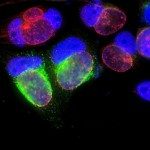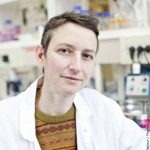Link to Pubmed [PMID] – 15916612
Mol. Microbiol. 2005 Jun;56(6):1636-47
Chlamydiae are strict intracellular parasites that induce their internalization upon contact with the host cell and grow inside an intracellular compartment called an inclusion. They possess a type III secretion (TTS) apparatus, which allows for the translocation of specific proteins in the host cell cytosol. In particular, chlamydial proteins of the Inc family are secreted to the inclusion membrane by a TTS mechanism; other TTS substrates are mostly unknown. Using a secretion assay based on the recognition of TTS signals in Shigella flexneri, we searched for TTS signals in the proteins of unknown function, conserved between three different chlamydial species, Chlamydia pneumoniae, C. trachomatis and C. caviae. We identified 24 new candidate proteins which did not belong to the Inc family. Four of these proteins were also secreted as full-length proteins by a TTS mechanism in S. flexneri, indicating that their translocation does not require other chlamydial proteins. One of these proteins was detected in the cytosol of infected cells using specific antibodies, directly demonstrating that it is translocated in the host cell during bacterial proliferation. More generally, this work represents the first directed search for TTS effectors not based on genetic information or sequence similarity. It reveals the abundance of proteins secreted in the host cell by chlamydiae.


